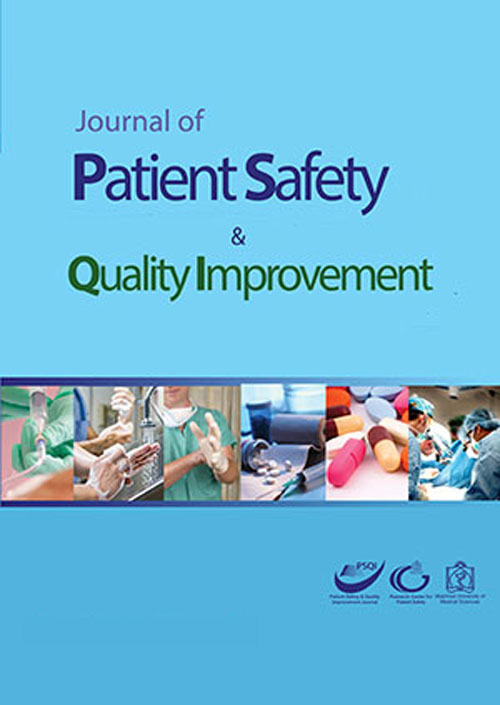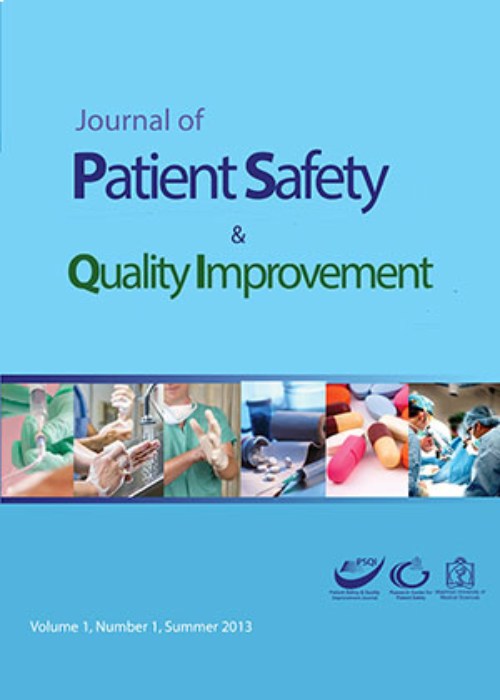فهرست مطالب

Journal Of Patient safety and quality improvement
Volume:3 Issue: 3, Summer 2015
- تاریخ انتشار: 1394/05/02
- تعداد عناوین: 9
-
Pages 238-242IntroductionClinical Governance (CG) is an overarching concept, using organizational capacity, safeguards high standards of the health services and provides a safe care for patients. The aim of this research was to study nurses’ perception about Clinical Governance.Materials And MethodsA qualitative study was done with Focus Group Discussions (FGD). Purposeful Sampling was used to select the objectives including 65 participants. Actually 7 FGD’s were held. Content analysis was used to extract the meaningful themes.ResultsNurses believed that patient centeredness and evidence based practice is the core of the CG concept. Also they mentioned that cultural change, staffs training, adequate financial and human resources are required to successfully implementation of CG in hospitals.ConclusionSpreading up a shared vision about CG and providing the required infrastructures in hospitals would be facilitate CG initiatives. Proper commitment of the managers and staff participation could lead an effective CG implementation.Keywords: Nurse Perception Clinical governance
-
Pages 243-246IntroductionTrigeminal Neuralgia (TN) is a unilateral, recurrent, sharp facial pain disorder that is limited to the distribution of divisions of the trigeminal nerve. The aim of this study was to evaluate the efficacy of Botulinum neurotoxin type A (BTX-A) for alleviating the frequency and severity of TN pain.Materials And MethodsThis trial was performed as a before and after study. We treated 31 patients (15 male and 16 female) with mean age of 52 year old that their diagnosis was made at least 4.5 years before. We injected BTX-A in various parts of face and particularly in the origin of mandibular and maxillary branches of trigeminal nerve. Injection volume was determined by the necessity and pain intensity measured with visual analog scale up to 100U. Patients were evaluated before and after the injection and were followed after week, and each month, for a three months period. Other related variables were recorded such as: toxin complications, pain status variations by brushing, chewing, cold weather and patient’s satisfaction with their therapy.Resultsshowed that after injection, pain intensity and frequency decreased after tooth brushing, chewing and cold weather (P<0.0001). Median of pain intensity decreased from 10 to 2 in all cases. Only 6% of patients affected to transient asymmetry and other complications were not observed. After 3 months of injection 71% of patients were inclined to reinjection.ConclusionBTX-A could be used as an effective and safe treatment method for drug resistant TN. Also it can be used in patients who are not satisfied with oral anticonvulsants.Keywords: Trigeminal neuralgia Botulinum neurotoxin type A Facial pain
-
Pages 247-251IntroductionSuicide is considered as a public health problem. Approximately 0.9% of all deaths worldwide are due to suicide. This study was performed to identify risk factors of suicide attempts among patients who admitted in a medical toxicology centre during three months.Materials And MethodsA cross sectional study was carried out; all admitted patients in our medical toxicology centre due to suicidal attempt who completed consent form were included from December to March 2013. A researcher designed questionnaire was prepared and its validity and reliability was confirmed; it was fulfilled by a psychologist via clinical interview. Data were analyzed by SPSS software 11.5 and results were discussed.Results198 participants included; of whom 67.2% were female and 94.9% were less than 45 year old. Among the patients, approximately 48% of the patients were married; 27.77% were employed. More than 96% suffered from severe depression, 3.53% of the patients had psychotic symptoms. Personality disorders, previous suicidal attempt, unemployment, full stressed family, family history of suicidal attempt, moderate to severe depression and a history of dependence on antipsychotic drugs and lack of family support were identified as risk factors for suicide.ConclusionAttention to personality trait and family environment can be mainly effective in long-term prevention of suicide, treatment of physical illness in patients with chronic health conditions, evaluation and treatment of psychiatric issues in addition to family and social problems, and organizing educational courses to families with suicide history can be helpful.Keywords: Risk factor Suicide Poisoning
-
Pages 247-251IntroductionSuicide is considered as a public health problem. Approximately 0.9% of all deaths worldwide are due to suicide. This study was performed to identify risk factors of suicide attempts among patients who admitted in a medical toxicology centre during three months.Materials And MethodsA cross sectional study was carried out; all admitted patients in our medical toxicology centre due to suicidal attempt who completed consent form were included from December to March 2013. A researcher designed questionnaire was prepared and its validity and reliability was confirmed; it was fulfilled by a psychologist via clinical interview. Data were analyzed by SPSS software 11.5 and results were discussed.Results198 participants included; of whom 67.2% were female and 94.9% were less than 45 year old. Among the patients, approximately 48% of the patients were married; 27.77% were employed. More than 96% suffered from severe depression, 3.53% of the patients had psychotic symptoms. Personality disorders, previous suicidal attempt, unemployment, full stressed family, family history of suicidal attempt, moderate to severe depression and a history of dependence on antipsychotic drugs and lack of family support were identified as risk factors for suicide.ConclusionAttention to personality trait and family environment can be mainly effective in long-term prevention of suicide, treatment of physical illness in patients with chronic health conditions, evaluation and treatment of psychiatric issues in addition to family and social problems, and organizing educational courses to families with suicide history can be helpful.Keywords: Risk factor Suicide Poisoning
-
Pages 252-256IntroductionThe prevalence of eating disorders have been increasing in recent decades; hence, the search for specific psychological variables that may help to identify the cause of this disorder is of great importance. The current study examined the mediating role of the anxiety on the relationship between perfectionism and disordered eating among female student.Materials And MethodsThis cross-sectional study was conducted in 2014 on a sample of 264 female students at Allameh Tabataba’i University, according to Morgan and cluster sampling selected. Afterward, participants completed the questionnaires of anxiety, perfectionism and eating attitudes test. The data were analyzed by SPSS software using coefficient correlation and stepwise regression. Statistical differences were considered significant at (P<0.01).ResultsThe results showed that there was internal significant correlation among anxiety, perfectionism and disordered eating (p<0.01). Also, regression analysis indicated that anxiety significantly mediated the relationship between perfectionism and disordered eating (p<0.01).ConclusionThe role of anxiety variable is important in prevention and therapy programs for perfectionism in eating disorders.Keywords: Anxiety Perfectionism Disordered eating Women
-
Pages 257-261IntroductionBehcet’s Disease (BD) is a general and progressive vasculitis and involves various organs. Its main etiology is not yet understood; however، immunologic and infectious causes and genetic predisposition have been proposed. Saccharomyces Cerevisiae is a type of yeast which is used in the bread and wine industries. Antibodies against this yeast have a well-proven role in inflammatory bowel diseases. The aim of the present study was to assess the frequency of Anti-Saccharomyces Cerevisiae Antibody (ASCA) and its relation to clinical symptoms and disease activity index in patients afflicted by BD.Materials And MethodsSerum ASCA levels، determined by ELISA، were Studied in Behcet’s disease along with oral aphthosis، other rheumatologic diseases and healthy volunteers (n=30 in each group). In the BD group the disease activity index and different clinical symptoms were recorded during the study course.ResultsSerum level of ASCA in the four studied groups of BD، oral aphthosis، other rheumatologic disease and healthy volunteers was 9. 18±9. 69، 10. 90±10. 40، 11. 29±17. 96 and 8. 86±5. 31IU/ml، respectively; indicating no meaningful difference (p=0. 811). The ASCA titer was not related to Behcet’s disease severity (p=0. 399). Serum level of ASCA in BD patients with oral aphthosis or with gastrointestinal symptoms was significantly higher than the other Behcet’s Disease patients (p=0. 012، p=0. 014).ConclusionASCS is not a valuable test for distinguishing BD from recurrent oral aphthosis or other connective tissue disorders. It also cannot be used for determining disease severity. However، it has a higher level in BD patients with oral aphthous ulcers and gastrointestinal symptoms.Keywords: Behcet's disease Anti, Saccharomyces cerevisiae antibody Behcet's disease activity index
-
Pages 262-265IntroductionThe aim of this study was to compare the two analytical techniques for determination of Glycated hemoglobin (HbA1c), consisting immunoturbidimetric and enzymatic methods.Materials And MethodsA total of 140 out-patients were included in this study. Measurements of HbA1c were done in blood samples using immunoturbidimetric and enzymatic assay. The two methods were used by clinical laboratories of Ghaem and Emam Reza hospitals in Mashhad, respectively.ResultsOur results indicate that there was no significant difference between two methods, though; the average of HbA1c measured by enzymatic method was rather higher than the other method (7.38 and 7.34, respectively). The two methods correlated well with correlation coefficient of 0.967.ConclusionBoth techniques were proved to be sufficiently reliable and the results of the two methods show strong correlation though, the enzymatic method has an additional advantage of simultaneous measuring total Hb which can omit the undesired effect of hemolysis occurring during sampling.Keywords: HbA1c Immunoturbidimetric Enzymatic assay
-
Pages 266-268Mucosal damage in Gastro Intestinal (GI) system happens due to stress and is more common in upper part of GI tract in patients admitted to Intensive Care Unit (ICU). This kind of injuries occurs in critically ill patients. Stress ulcer prophylaxis is necessary and increases the gastric (Power of Hydrogen) pH (more than 4) especially in stress exposure time. In this paper we provide an overview of stress ulcer and currently used preventive approaches for this complication in critically ill patients in ICU. Recent promotion in ICU care and increase in scientific knowledge about Stress-Related Mucosal Disease (SRMD) risk factors help us to reduce the number of patients develop stress ulcer. Prophylaxis can prevent significant bleeding and mortality.Keywords: Mucosal damage Gastro intestinal Intensive care unit
-
Pages 269-272IntroductionThe aim of this study was to evaluate the efficacy of acupuncture therapy on relieving ocular symptoms in resistant Ocular Myasthenia Gravis (OMG). Case: In this pilot study, three patients with OMG were offered ten sessions of acupuncture therapy, twice weekly, while they received their routine medical treatment. Their symptoms included ptosis and diplopia. Subjective impression of changes was assessed based on Ocular-quantitative Myasthenia Gravis (QMG) scoring before and after treatment sessions.ConclusionAll three patients enrolled in this study showed resolution of diplopia. Their subjective impression of symptoms was improved. However, the score of ptosis did not improve considerably. Acupuncture is another choice for reducing ocular symptoms besides conventional treatment in resistant Ocular Myasthenia Gravis (OMG). However, future randomized controlled trial studies are needed to approve this issue.Keywords: Myasthenia gravis Acupuncture Complementary, alternative medicine


